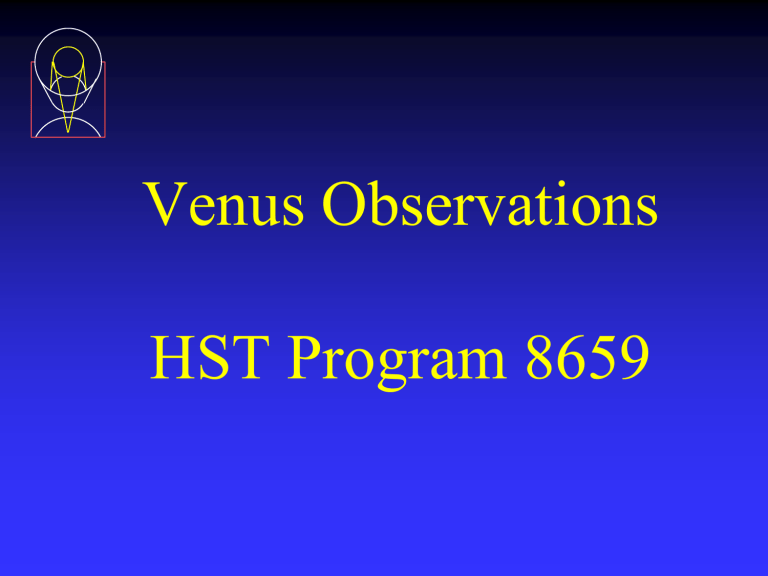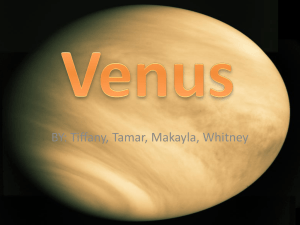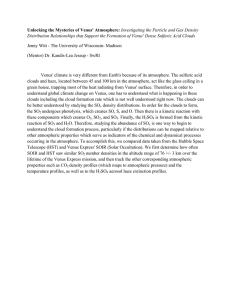Venus Observations HST Program 8659

Venus Observations
HST Program 8659
Objectives
Explain Venus observing strategy.
Review areas of special concern with Venus observations and explain how these concerns are being addressed.
Determine if the implementation is correct and complete.
Why Is Venus Special?
At its farthest, Venus gets to be about 47 degrees from the Sun.
HST is normally not permitted to point within 50 degrees of the Sun.
Venus Observing Program History
In cycle 4, HST observed Venus with GHRS and WFPC2
(GO programs 4518 and 5783).
In cycle 6, two GO Venus proposals (6607 and 6771) were approved by the TAC; and there was one GTO/WF2 program (6851) to observe Venus. All of these were cancelled by the Director shortly after phase 2 submission.
In cycle 7, there was a GTO/STIS program (7581) to observe Venus. Much implementation work was done, but the program was then withdrawn by the PI.
Venus Observing Program History
In cycle 9, the TAC approved GO program 8659 to observe Venus. This program was planned for
June 2001 but did not execute due to the failure of
STIS side 1 electronics.
Program 8659 is now re-planned for January 26,
2003.
Scientific Goals
High resolution STIS spectrum of Lymana
Assess the abundance of deuterium in the Venus atmosphere
Constrain models of Venus atmosphere and climate evolution
Observing Strategy
Observe while Venus is near maximum elongation
In cycle 11, there are two 10 day long windows separated by 6 months.
Observe while HST is in Earth’s shadow
A window of 11-13 minutes per orbit
One HST orbit is sufficient to conduct observation.
Generic TDRSS scheduling will be employed.
Which Elongation?
Eastern: August 2002, Western: January 2003
Both are possible, but Western is easier.
Eastern vs. Western Elongation
Eastern Elongation:
Target Visibility
Shadow
Western Elongation:
Target Visibility
Shadow
Observing Strategy Details
Target Visibility Target Visibility
Shadow
GS Pair Acq at Venus+5D
Slew to Venus
Single GS Acq at Venus
Observe Venus
Slew to
Venus+5D
Initial GS Acq at Venus+5D
A pointing 5 degrees from Venus and 51.01 degrees from the Sun.
Minimizes slew distance to Venus
Precautionary measure to protect against large pointing error after slew
Observe
Venus+5D
GS Pair Acq at
Venus+5D
Observing Strategy Details
Target Visibility Target Visibility
Shadow
GS Pair Acq at Venus+5D
Slew to Venus
Single GS Acq at Venus
Observe Venus
Single GS Acq at Venus
Saves about a minute versus pair acquisition
Slew to
Venus+5D
Observe
Venus+5D
GS Pair Acq at
Venus+5D
Venus science observation
4.25m exposure
STIS auto wave cal disabled
Observing Strategy Details
Target Visibility Target Visibility
Shadow
GS Pair Acq at Venus+5D Single GS Acq at Venus
Observe Venus
Slew to Venus
Venus+5D Observation
Geocoronal Lymana foreground and interplanetary Lymana background.
16m exposure
For subtraction from Venus Lyman-alpha line
Slew to
Venus+5D
Observe
Venus+5D
GS Pair Acq at
Venus+5D
Venus Appearance at Observation
Sun angle: 46.00 degrees
Apparent magnitude: -4.4
Surface brightness: +1.5 (average for 1 square arcsecond of illuminated portion of disk)
Apparent diameter: 21.12 arcseconds
Phase angle: 81.24 degrees
Areas of Concern
Guide star acquisition failure
Spacecraft of instrument problem shortly before scheduled observing time
FGS exposure to Venus
HST being exposed to sunlight while pointed within the Solar Avoidance Zone (SAZ)
HST safing while pointed within the SAZ
Guide Star Acquisition Failure
Concern
If attitude error is greater than the search radius, the guide star acquisition could fail resulting in the loss of the science.
Precautions
The chances are minimized by the short 5 degree slew to Venus.
In cycle 4, additional FHST maps were also inserted by
GSFC; but now there are automatic FHST maps, so this is not an issue.
Guide Star Acquisition Failure
Precautions
A guide star acquisition test was planned in advance.
Guide star ID is 00624100797.
Test successfully completed on July 15, 2002.
Problem Shortly Before Observation
Concern
An unrelated problem may threaten the Venus observing window.
In cycle 4, the Venus observation was originally lost due to an unrelated safing; but it was quickly replanned and executed successfully.
In May 2001, the current program was delayed due to the failure of the STIS side 1 electronics.
Problem Shortly Before Observation
Remedy
The current Venus observation could probably be rescheduled within a couple of weeks after January 26.
A reduction of exposure time or an additional orbit would be required.
The Sun angle would be reduced to 44-45 degrees.
There might be conflicts with other time critical observations.
FGS Exposure To Venus
Concern
If the attitude error is large enough (> 300 arcseconds), an FGS could possibly see Venus and cause potential bright light exposure to the FGS photo-multiplier tubes.
Precautions
Choose a guide star that is as far as possible from
Venus.
The chosen guide star is magnitude 11.1 and will be about 16.2 arcminutes from Venus.
HST FOV
HST in the Sun
Concern
While slewing away from Venus, HST will be exposed to sunlight and pointed inside the SAZ for ~3m 0s.
In cycle 4, the maximum time that HST was exposed to sunlight while pointed inside the SAZ was ~2m 20s.
Pointing inside the SAZ while HST is in sunlight can be tolerated for a maximum of about 15 minutes before the temperature of the paint inside the OTA would become a contamination issue.
HST in the Sun
Precautions
Guide star search radius could be reduced in order to save
~30 seconds of acquisition time.
This would reduced HST’s time in sunlight to ~2m 30s.
In cycle 4, the slew away from Venus was started sooner by editing the SMS to reduce the time pad between
PCPTERM and slew from 60s to 20s.
This pad has since been reduced to 15s, so there is no longer any time to be saved here.
HST Safing
Concern
If HST were to enter inertial hold safe mode while pointed within the SAZ, that would be bad.
Precautions
Disable inertial hold safe mode such that any condition that would normally lead to inertial hold leads to software sun point safe mode instead.
This was done in cycle 4.
HST Safing
Concern
If there is an anomaly with the 486 flight computer, software sun point safe mode might not be achieved.
Precaution
Be ready to command HST into hardware sun point safe mode.
Proposed Schedule for Remaining
Preparation
Observation will be part of SMS 2003.025
Calendar boundary moved to 2003.025:23 from 2003.027 due to tight constraints of GOODS and KBO large programs which are executing in the same time period.
Test SMS to GSFC: week of December 16, 2002.
2003.025 calendar starts building on January 16, 2003.
Pre-FRR: January 17, 2003 10:00-11:00 LMB 229 (video conference with STScI in room 112)
FRR: January 21, 2003 9:30-11:00 NASA Building 3 room
S107A (video conference with STScI in room 112)
Additional Information
Detailed Timeline between Begin guide star acquisition at VENUS+5D. (VENUS+5D is a pointing 5 degrees
2003.026:08:11:01 from Venus in the direction away from the Sun. Sun angle for this pointing is 51.01
and degrees) Exactly when this falls in this orbit depends on what other unrelated
2003.026:09:07:14 observations precede it in the schedule. The important thing is that this will take place in the orbit before the Venus observation.
2003.026:09:07:14 VENUS-CRESCENT enters Earth avoidance. (VENUS-CRESCENT is the science target. It is a pointing a few arcseconds offset from the center of Venus. Sun angle for this pointing is 46.00 degrees.)
2003.026:09:32:28 HST enters Earth’s shadow
2003.026:09:41:24 begin slew to VENUS-CRESCENT
2003.026:09:47:02 end slew
2003.026:09:47:02 begin guide star acquisition
2003.026:09:47:08 VENUS-CRESCENT exits Earth avoidance
2003.026:09:53:34 end guide star acquisition
2003.026:09:53:42 begin science observation of VENUS-CRESCENT
2003.026:10:01:18 end science observation
Detailed Timeline
2003.026:10:01:23 begin slew to VENUS+5D
2003.026:10:02:56 HST exits Earth's shadow
2003.026:10:07:00 end slew
2003.026:10:07:00 begin guide star acquisition at VENUS+5D
2003.026:10:13:32 end guide star acquisition
2003.026:10:13:40 begin science observation at VENUS+5D
2003.026:10:33:01 end science observation
2003.026:10:33:01 begin STIS readout
2003.026:10:36:01 end readout
2003.026:10:36:01 begin STIS wavelength calibration
2003.026:10:37:27 end wavelength calibration
2003.026:10:37:27 begin STIS readout
2003.026:10:38:26 end readout
2003.026:10:38:26 begin end-of-visit overhead
2003.026:10:42:48 end visit 01 of program 8659
RA, DEC, Sun Angle, Roll
HST will be at nominal roll (99 degrees V3) during Venus Observation
Time R.A. Dec. Sun Sep.
(utc) (degrees) (degrees) (degrees)
=============================================================
2003-JAN-26 09:15:00.0 259.1056 -20.0229 46.01
2003-JAN-26 09:20:00.0 259.1096 -20.0234 46.01
2003-JAN-26 09:25:00.0 259.1136 -20.0238 46.01
2003-JAN-26 09:30:00.0 259.1177 -20.0243 46.01
2003-JAN-26 09:35:00.0 259.1217 -20.0247 46.01
2003-JAN-26 09:40:00.0 259.1257 -20.0252 46.01
2003-JAN-26 09:45:00.0 259.1297 -20.0256 46.01
2003-JAN-26 09:50:00.0 259.1338 -20.0261 46.01
2003-JAN-26 09:55:00.0 259.1378 -20.0265 46.00
2003-JAN-26 10:00:00.0 259.1418 -20.0270 46.00
2003-JAN-26 10:05:00.0 259.1458 -20.0274 46.00
RA, Dec, Sun Angle, Roll
Time R.A. Dec. Sun Sep.
(utc) (degrees) (degrees) (degrees)
=============================================================
2003-JAN-26 10:10:00.0 259.1499 -20.0278 46.00
2003-JAN-26 10:15:00.0 259.1539 -20.0283 46.00
2003-JAN-26 10:20:00.0 259.1579 -20.0287 46.00
2003-JAN-26 10:25:00.0 259.1619 -20.0292 46.00
2003-JAN-26 10:30:00.0 259.1660 -20.0296 46.00
2003-JAN-26 10:35:00.0 259.1700 -20.0301 46.00
2003-JAN-26 10:40:00.0 259.1740 -20.0305 46.00
2003-JAN-26 10:45:00.0 259.1780 -20.0310 46.00
2003-JAN-26 10:50:00.0 259.1821 -20.0314 46.00
2003-JAN-26 10:55:00.0 259.1861 -20.0319 46.00
2003-JAN-26 11:00:00.0 259.1901 -20.0323 46.00
2003-JAN-26 11:05:00.0 259.1941 -20.0327 46.00
2003-JAN-26 11:10:00.0 259.1982 -20.0332 46.00
2003-JAN-26 11:15:00.0 259.2022 -20.0336 46.00
Guide Star IDs
The guide star system gave the following suitable pairs to use for the setup pointing prior to the Venus observation:
0622702670F10622701453F2
0622600804F20622701480F1
0622600624F20622701753F1
0622601774F20622701175F3
0622601058F20622600428F3
0622601619F10622600428F3
0622701753F10622600138F2
0622601619F10622601058F2
0622600800F20622601581F1
0622601530F10622600428F3
0622600376F20622601581F1
0622601619F10622600290F3
0622600708F20622600772F3
0622601058F20622601530F1
0622600820F20622601372F3
0622601372F30622601577F2
0622600138F20622700591F3
0622702670F10622700796F2
0622600506F20622601372F3
0622702670F10622700972F2
0622701753F10622700591F3
0622600020F20622601581F1
0622600624F20622601581F1
0622701480F10622700829F3
0622600612F20622601372F3
0622601372F30622600548F2
0622601204F20622601581F1
0622600290F30622601530F1
0622601204F30622601581F1
Guide Star IDs
The guide star for the Venus observation is
0624100797F1.
For the pointing to which HST will slew after Venus, the guide star system gave the following suitable pairs:
0622600624F2 0622601629F1
0622601018F2 0622600826F2
0622600376F2 0622600652F2
0622701175F3
0622700806F3
0622700454F3
0622601701F1
0622600800F2
0622701445F3
0622601879F2
0622601628F1
HST’s View of Venus (t = 0)
Sun
Earth
Venus
Venus+5D
Venus is in Earth occultation. The Sun is not. HST would be pointed at Venus+5D at this time.
HST’s View of Venus (t = 5 min)
The Sun is moving toward setting.
HST’s View of Venus (t = 10 min)
The Sun is moving toward setting. The terminator becomes visible on the Earth.
HST’s View of Venus (t = 15 min)
The Sun is very close to setting.
HST’s View of Venus (t = 20 min)
The Sun has set. HST is now in the Earth’s shadow.
HST’s View of Venus (t = 25 min)
Venus is very close to rising. At about this time, HST will begin its slew from Venus+5D to Venus
HST’s view of Venus (t = 30 min)
Venus has risen. At about this time, HST will complete its slew to Venus; and the guide star acquisition will begin.
HST’s View of Venus (t = 35 min)
At about this time, the guide star acquisition will finish; and the science observation will begin.
HST’s View of Venus (t = 40 min)
At about this time, the science observation will finish; and the slew to Venus+5D will begin.
HST’s View of Venus (t = 45 min)
The Sun is very close to rising.
HST’s View of Venus (t = 50 min)
The Sun has risen. HST is now out of the Earth’s shadow.
The slew to Venus+5D finishes a couple of minutes after sunrise.







